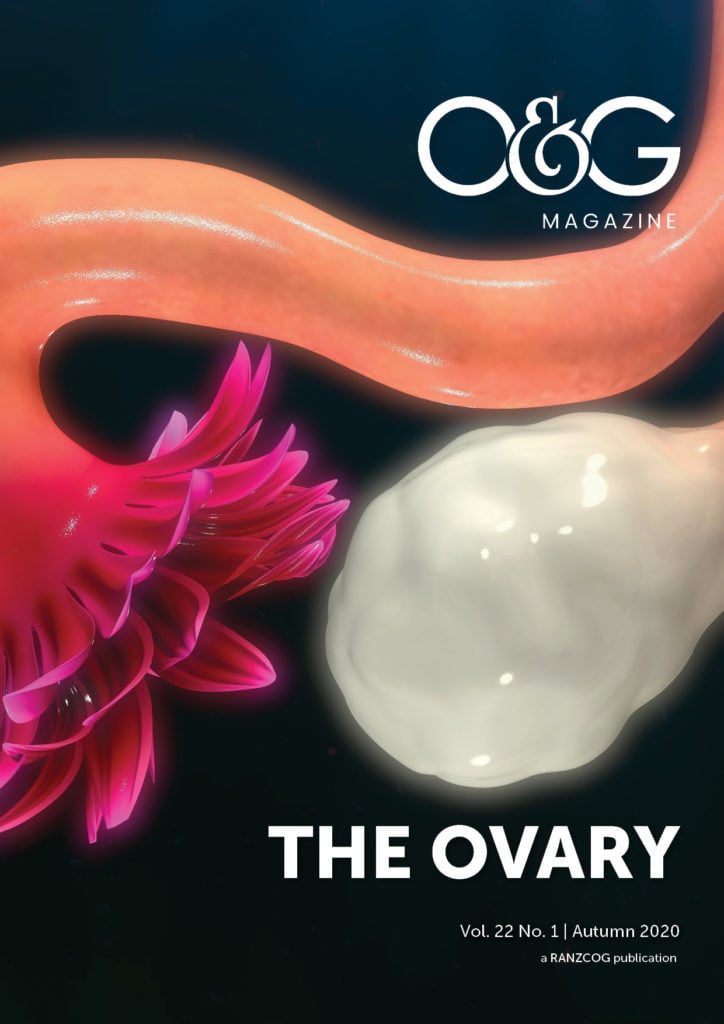Gynaecologists are frequently confronted with the quandary of an ultrasound report stating that there is a ‘complex ovarian cyst’, especially when the ultrasound has not been performed by a specialist with a certificate of obstetric and gynaecological ultrasound (COGU). Complex is a very vague term that does not adequately guide further management. The questions the referring gynaecologist wants answered by an ultrasound can be broadly described as:
- Is the cyst likely to resolve on its own?
- Am I able to remove the cyst laparoscopically?
- Is the risk of cancer sufficiently high that I should refer the patient to a gynaecological oncologist to perform the surgery?
Until recently, answers to these questions have been difficult to obtain, as much of the data on the ultrasound appearance of different types of cysts has been empirical and based largely on expert opinion. The International Ovarian Tumour Analysis group (IOTA) has, over the last two decades, proposed standardised definitions for adnexal lesions and has conducted a great many retrospective and prospective trials with extensive surgical and pathological follow up. The IOTA methodology has also been prospectively evaluated by other centres with good correlation. This has enabled IOTA to propose rules (IOTA Simple Rules) and a computer-based model (ADNEX) to more accurately identify the risk of malignancy of an adnexal lesion. The IOTA group is a multinational collaboration, membership is obtained by attending a workshop and then successfully passing an examination. It is possible to check if your preferred ultrasound specialist has passed this examination via www.iotagroup.org/certified-members.
The IOTA models have been shown in several studies to perform much better at the detection of malignancy than the older risk of malignancy index (RMI) or OVA1 algorithms.1
Many national bodies have recommended using the IOTA models, including the Royal College of Obstetricians and Gynaecologists,2 American College of Obstetricians and Gynecologists3 and, most recently, the American College of Radiology through their Ovarian-Adnexal Reporting and Data System ultrasound risk stratification and management system (O-RADS).4
Classical ovarian lesions
The IOTA technique of assessing an ovarian mass begins with identifying several classical ovarian lesions, referred to as ‘simple descriptors’. These are:
- Simple cyst: unilocular, no internal material (anechoic), thin walled and avascular.
- Corpus luteum: unilocular with peripheral vascularity (‘ring of fire’), second half of the cycle and associated with a secretory endometrium (unless there is a Mirena insitu). These often appear haemorrhagic.
- Haemorrhagic cyst: unilocular, reticular pattern of fine thin intersecting lines (fibrin strands).
- Endometrioma: homogeneous low-level internal echoes ‘ground glass’, minimal vascularity, smooth walled. Often bilocular, often bilateral.
- Dermoid/teratoma: avascular, usually unilocular but with variable internal structure due to the differentiating cell types, most commonly hair (fine linear dots and dashes) and fluid levels (due to different fluid types). Classically dermoids have shadowing echogenic areas due to calcification.
- Invasive malignancy: large irregular solid mass, highly vascular, usually no visible normal ovarian tissue remaining, ascites (defined by IOTA as fluid above the level of the uterine fundus to differentiate from physiological pelvic fluid commonly seen after ovulation).
These classical lesions do not usually cause much uncertainty about the management pathways once they have been correctly identified on ultrasound.
Haemorrhagic cysts often resolve spontaneously. A repeat ultrasound in two–three months can be considered to ensure cyst resolution. Ideally, this ultrasound should be performed just after a period to prevent confusion with a new corpus luteum. Endometriomas and dermoids, if not removed, should have annual follow up as there is a risk of malignant transformation, especially post menopause.5
Unfortunately, there are many ovarian lesions that do not fit these classical descriptions. For these less straightforward lesions, IOTA propose using Simple Rules or the ADNEX algorithm to guide further management.
IOTA Simple Rules
The Simple Rules technique highlights five features most associated with a lesion being benign and five features most associated with a lesion being malignant (Table 1). The rules are that if the lesion has only benign features then it can be considered benign or if the lesion has only malignant features then it can be considered malignant. If none of the 10 benign or malignant features are seen or if there are both benign and malignant features present, then the lesion is unclassifiable. After exclusion of the ‘classical lesions’ (dermoid, endometrioma, simple cyst, etc) about 75% of lesions can be classified in prospective studies for a 95% sensitivity and 91% specificity.6 The 25% of unclassifiable lesions could be sent for second opinion from an expert (such as a COGU) or have the ADNEX model applied. This technique has been validated prospectively by imaging specialists with no specific gynaecological experience with similar accuracy.7
Table 1. IOTA features used for the Simple Rules.
| Benign features | Malignant features |
| Unilocular cyst | Irregular solid lesion |
| Solid components present, but < 7 mm | Ascites (fluid above the top of the uterus) |
| Acoustic shadows | At least 4 papillary structures |
| Smooth multilocular lesion with largest diameter < 100 mm | Irregular multilocular-solid tumour with largest diameter ≥ 100 mm |
| No blood flow | Abundant blood flow |
The IOTA Assessment of Different Neoplasias in the Adnexa (ADNEX)
The ADNEX algorithm is available online8 or via a phone app. By entering specified ultrasound parameters, the imaging specialist can come up with a percentage risk of malignancy. IOTA have proposed that if the percentage risk is greater than 10%, further management should be performed by a gynaecological oncologist. The ADNEX model has been prospectively shown to have 92–95% accuracy for a 10% false-positive rate.9 CA 125 can also be incorporated into the ADNEX model and is mostly used to help distinguish stage 1 ovarian cancer from stage 2–4, borderline or metastatic cancer to the ovary. CA 125 has only minimal contribution to determining if the lesion is benign or malignant as it is often in the normal range with stage 1 ovarian cancer. This highlights that CA 125 in isolation is not a good screening test to identify stage 1 ovarian cancer.10
Other considerations in evaluating ovarian lesions
Transvaginal ultrasound generally provides much more accurate assessment of a lesion than transabdominal, especially when looking for blood flow. There are, however, instances where transvaginal ultrasound cannot be performed, such as virgo intacta or patient refusal. There are also circumstances where transvaginal accuracy is reduced, such as increased BMI and greatly enlarged fibroid uterus (which often elevates the ovaries high into the abdomen).
Most simple cysts in the reproductive age range are functional and will resolve within two–three cycles. Simple cysts less than 3 cm should be considered physiological (a follicle) and reported as such with no follow up required. Cysts more than 10 cm in diameter are more difficult to fully assess with ultrasound; particularly, blood flow and small projections may not be seen in the deep aspect of a large cyst, leading to erroneous classification. Repeat ultrasound in three months, pelvic MRI or surgical removal can be valid management options.
Many simple cysts over 2 cm in the postmenopausal patient are small cystadenomas and review should be considered. The exact interval has not yet been determined, but review in three months11 and, if no change, six months, and then yearly if the cyst remains stable, could be considered.
Septations are common in benign cystadenomas but also in malignant tumours with borderline tumours frequently having more than 10 septations.
Papillary projections are wall projections that are at least 3 mm in height, perpendicular to the wall. Four or more projections, or projections involving more than 50% of the internal cyst wall, are suspicious features for malignancy. The larger the projection or solid area is compared to the overall cyst size, the greater the risk of malignancy.
Vascularity demonstrated within a solid area, papillary projection or in a septum is a concerning feature. Vascularity is measured with colour or power Doppler. Resistance index (RI) has been used historically, with a level less than 0.4 considered high risk for malignancy, but is no longer recommended due to very poor sensitivity and specificity. RI is still occasionally used to demonstrate that the flow is arterial rather than ultrasound artefact.
Solid masses with no vascularity, especially with irregular calcifications, are often fibromas, which are almost always benign. Solid masses with increased vascularity are almost always malignant, sometimes secondary tumours to the ovary (Krukenberg tumours).
Secondary metastases to the ovaries are always vascular and often, but not always, bilateral. They originate most commonly from the stomach, but also from other bowel and biliary sites and the breast. They can be solid tumours (gastric, breast, lymphomas) but can also be large multilocular with solid areas (colon, rectum, pancreas/biliary tract). Additional investigations to consider if a secondary tumour to the ovary is suspected (to find a possible primary) may include PET-CT, MRI whole body diffusion, gastroscopy, colonoscopy and x-ray mammography.
Tumour markers that may be of use include CA 125, but as previously stated, a low CA 125 level does not exclude stage 1 ovarian cancer. CA 125 also has many false positives including, but not limited to, adenomyosis, endometriosis and diverticular disease. CA 19-9 may be raised in mucinous tumours including cystadenocarcinoma, borderline tumours and secondaries from the bowel. Germ cell tumours may have raised αFP or βHCG.
Conclusion
When evaluating an ovarian lesion, it is important the ultrasound is performed and reported by clinicians able to assess and describe the lesion appropriately. Some lesions are classical and easily described (such as endometriomas and dermoids) but many are less certain. Using IOTA Simple Rules and/or the ADNEX model has shown good value to identify the risk of malignancy and both are more accurate than RMI. CA 125 is useful to identify advanced cancer, but has a limited role in the detection of stage 1 ovarian cancer due to significant false positive and false negative rates.
References
- Sayasneh A, Ekechi C, Ferrara L, et al. The characteristic ultrasound features of specific types of ovarian pathology (review). Int J Oncol. 2015;46(2):445-58.
- Royal College of Obstetricians and Gynecologists, British Society of Gynecological Endoscopy. Management of suspected ovarian masses in premenopausal women. Green Top guidelines 62, 2011. Available from: www.rcog.org.uk/en/guidelines-research-services/guidelines/gtg62/.
- Practice Bulletin No. 174 Summary: Evaluation and Management of Adnexal Masses. Obstet Gynecol. 2016;128(5):1193-5.
- Andreotti RF, Timmerman D, Strachowski LM, et al. O-RADS US Risk Stratification and Management System: A Consensus Guideline from the ACR Ovarian-Adnexal Reporting and Data System Committee. Radiology. 2020;294:168-85.
- Van Holsbeke C, Van Calster B, Guerriero S, et al. Endometriomas: their ultrasound characteristics. Ultrasound Obstet Gynecol. 2010;35(6):730-40.
- Timmerman D, Testa AC, Bourne T, et al. Simple ultrasound-based rules for the diagnosis of ovarian cancer. Ultrasound Obstet Gynecol. 2008;31(6):681-90.
- Sayasneh A, Ferrara L, De Cock B, et al. Evaluating the risk of ovarian cancer before surgery using the ADNEX model: a multicentre external validation study. Br J Cancer. 2016;115(5):542-8.
- International Ovarian Tumour Analysis. ADNEX risk model. Available from: www.iotagroup.org/research/iota-models-software/adnex-risk-model.
- Van Calster B, Van Hoorde K, Froyman W, et al. Practical guidance for applying the ADNEX model from the IOTA group to discriminate between different subtypes of adnexal tumors. Facts Views Vis Obgyn. 2015;7(1):32-41.
- Timmerman D, Van Calster B, Jurkovic D, et al. Inclusion of CA-125 does not improve mathematical models developed to distinguish between benign and malignant adnexal tumors.
J Clin Oncol. 2007;25(27):4194-200. - van Nagell JR, Miller RW. Evaluation and management of ultrasonographically detected ovarian tumors in asymptomatic women. Obstet Gynecol. 2016;127:848-58.






Leave a Reply